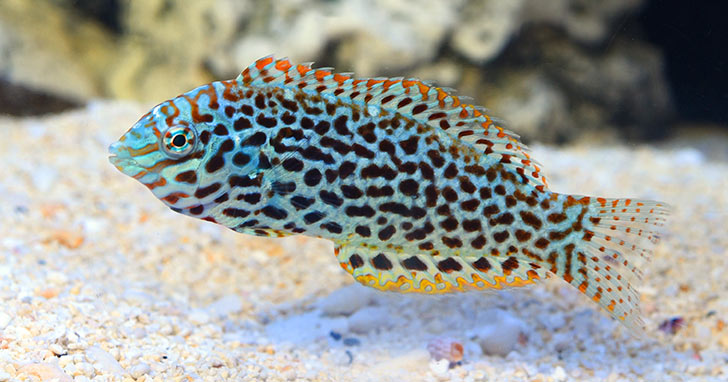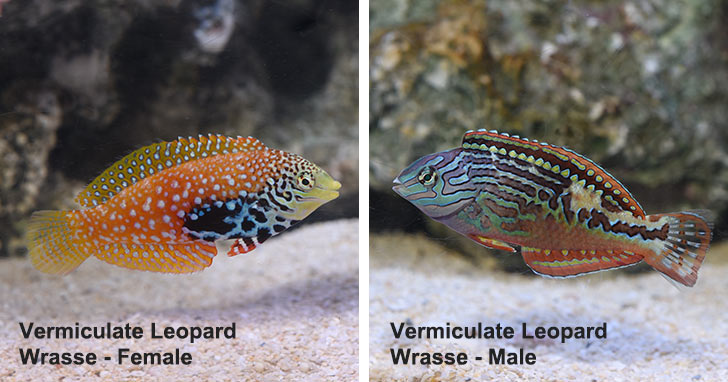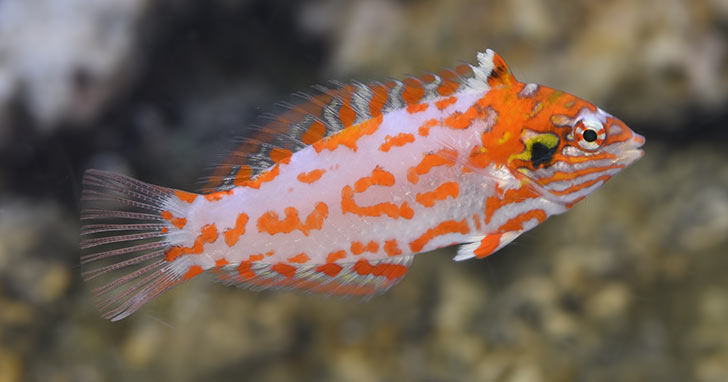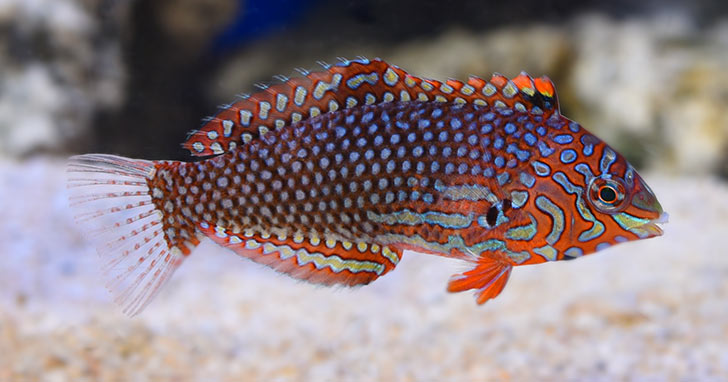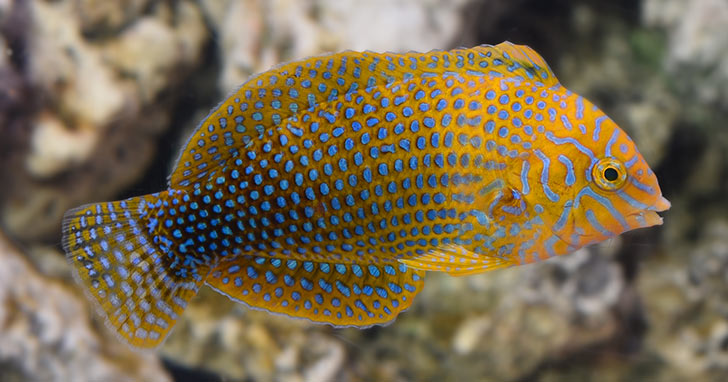Leopard Wrasse of the Genus Macropharyngodon
Some of the more unique species of eye-catching wrasse belong to the genus Macropharyngodon. Collectively known as Leopard Wrasse, Macropharyngodon wrasse are arguably some of the most attractive marine fish for the moderate sized aquarium. Currently, there are 12 recognized species that make up the genus Macropharyngodon. All species share similar attributes that make them so alluring. The combination of a laterally compressed body shape combined with a myriad of colors and leopard-type pattern evokes an immediate “I want that wrasse” response! Further bolstering this desire is their interesting swimming style of bobbing up and down and weaving back and forth which is both methodical and captivating. Leopard wrasse swim with purpose as they are always foraging and hunting for their next meal. Some feel this intriguing swimming behavior of Macropharyngodon wrasse is also used to confuse or deter an approaching predator.. Depending on the species, Leopard wrasse have a vast range of distribution throughout the Indian and Pacific Oceans where they can be found swimming among the corals and coral rubble of reefs. Leopard Wrasse are very active during daylight hours, constantly on the prowl for small invertebrates, crustaceans, and snails to feed on.
Caring for Leopard wrasse poses unique challenges as they require dedicated care and acclimation very similar to that of other sensitive species of wrasse including Tamarin Wrasse of the genus Anampses. Macropharyngodon wrasse are highly susceptible to stress-related injuries especially during shipping. During transport, the confines of the bag and package can often trigger an instinctive burrowing behavior, which can be damaging and detrimental as the fish may injure its mouth as it tries to burrow for safety while contained. Evidence of this stress-related injury can often be seen on Macropharyngodon wrasse newly arriving to our LiveAquaria® Coral Farm & Aquatic Life Facility which we promptly treat with an antibiotic after proper acclimation. To help ease the transition to aquarium life, all new arrivals to our LiveAquaria® Coral Farm & Aquatic Life Facility are acclimated under red light or “dark room” conditions. During this initial stage of acclimation, all regular overhead lights in the QT (quarantine) system of our Aquatic Life and Coral Farm facility are shut off and only the red lights are used to create a relaxed and subdued atmosphere. The red lights remain on for a minimum of 24 hours after the fish are introduced into the QT system before the regular lights are turned on at a lower intensity over the course of the following day or two depending how the fish are acclimating. Almost all Leopard wrasse arriving at our LiveAquaria® Coral Farm & Aquatic Life Facility are acclimated in our QT system which employs low salinity (1.018 sg) water and a therapeutic level (0.15 ppm) of ionic copper sulfate to help with the osmoregulatory process and eradicate any potential parasites. The wrasse are closely observed over the next two weeks or longer and treated for any other maladies as needed. The exception to our medicated quarantine protocol is the Choat’s Leopard Wrasse (Macropharyngodon choati), since our LiveAquaria® experts feel that Choat’s Leopard Wrasse are sensitive to copper sulfate. Choat’s Leopard Wrasse are kept together in groups in their own separate, copper-free aquariums that contain soft, sandy substrate that provides an escape or hiding space for the wrasse to burrow when needed.
After initial acclimation and observation, the next step involves conditioning the wrasse to accept frozen/thawed foods. Some newly acquired groups of wrasse will start eating within a day or so while others might take up to a week before accepting a prepared diet of brine shrimp and mysis shrimp fortified with VitaChem. If you are caring for a Macropharyngodon wrasse that challenges you with a picky palate, you may need to resort to live food items like brine shrimp, different types of copepods, or even bloodworms. Usually the movement of live food will elicit a feeding response. After success with live foods, the wrasse will typically accept their frozen counterparts within a short time frame. Another critical aspect to the successful care of any Leopard wrasse is to provide an established aquarium with plenty of live rock and a live sand substrate layer at least 2 inches in depth. This will help host a healthy population of copepods for the wrasse to feed on which, in turn, provides enrichment for the wrasse since it offers a more natural hunting ground. The deep sand substrate layer also provides a safe outlet for the wrasses’ natural burrowing behavior and also doubles as shelter for the wrasse to disappear or sleep in at night. The only potential negative, or con to an established aquarium is that some established tank-mates can be overly aggressive, or bully the newly introduced, more passive Leopard wrasse. Angelfish of the genus Centropyge, Tangs, Hawkfish, and Damsels can potentially harm or stress any Leopard wrasse. Whenever possible, Leopard wrasse should be introduced before any potentially aggressive fish so they are able to establish themselves in the aquarium first. Like all wrasses, Leopard wrasse are jumpers so be sure to fit your aquarium with a suitable cover or lid to prevent accidental deaths of your beloved fish.
Leopard wrasse typically appreciate the company of their own species, potentially forming a thriving harem comprised of one male and multiple females. Keep in mind two males of the same species should not be housed together. Macropharyngodon species are protogynous hermaphrodites, meaning juveniles are born female and have the ability to turn into a male when needed. With that said, a group of 3 or 4 juveniles will eventually establish a harem with one of the juveniles transitioning to a male while the rest remain female. If something should happen and the harem male perishes due to predation or disease, the next highest-ranking female will transition into a male. In general, Macropharyngodon wrasse can be housed with other wrasse species and even other Macropharyngodon wrasse. However, it is best to avoid two male Macropharyngodon wrasse even if they are different species since they may consider each other a rival or threat due to similarity in appearance. Whenever Leopard wrasse are offered for sale and sold on the Diver’s Den® WYSIWYG Store, we do everything we can to mitigate any potential stress to ensure safe and successful transit. All Diver’s Den® orders of sensitive fish, such as Leopard wrasse, are identified and shopped last to limit their time in the shipping bag and box. After sensitive fish orders are shopped and bagged, they are promptly packaged in their shipping box to provide complete darkness to help calm the fish. Due to their sensitivity and special requirements all Leopard wrasse are considered “Expert Only” and not recommended for the new or inexperienced aquarist. Expert understanding of marine aquariums and marine fish care is paramount for successful long-term care of Leopard wrasse. That being said, any Macropharyngodon wrasse will make incredible display fish in the proper marine aquarium when kept by capable aquarists.
All of the Leopard wrasse shown here in this article are frequently offered for sale on the Diver’s Den® WYSIWYG Store. In addition, more uncommon Leopard wrasse such as the Kuiter’s Leopard Wrasse (Macropharyngodon kuiteri), Black Leopard Wrasse (Macropharyngodon negrosensis) and Moyer’s Leopard Wrasse (Macropharyngodon moyeri) are offered for sale when available. Be sure to sign up for our Diver’s Den email alerts to be notified of new aquatic life being offered for sale on the Diver’s Den® WYSIWYG Store! Be alerted when the Divers Den® gets updated each day! Sign up for our Diver's Den Email Alerts Learn how to increase your chance of bringing home that prized, highly desirable and anticipated species HERE > |
||||||||||
|
|


